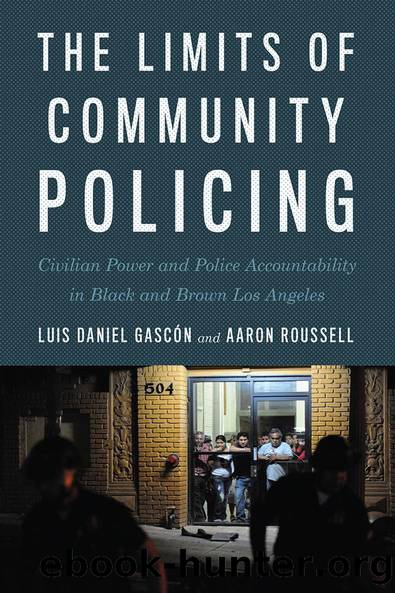The Limits of Community Policing by Luis Daniel Gascón Aaron Roussell

Author:Luis Daniel Gascón, Aaron Roussell [Luis Daniel Gascón, Aaron Roussell]
Language: eng
Format: epub
Tags: Social Science, Criminology
ISBN: 9781479807567
Google: L1ZxDwAAQBAJ
Publisher: NYU Press
Published: 2019-07-23T05:25:29+00:00
5
No Place for the Mom-and-Pops
We donât want the Home Depot to get up and leave.
âCaptain Himura
One of the first challenges Captain Himura set for himself upon his arrival was to reduce Part 1 crime in the division by 5 percent. Focusing particularly on property crime, Himura decided to make strategic use of his community policing tools, strengthening the divisionâs crime-prevention capacity by increasing the size of the Community Relations Office and emphasizing the âBusiness Car.â Officers assigned to this car would liaise specifically with local business interests to learn about and service their âseparate concerns,â as Himura put it. At the same time, he began organizing meetings with several corporate boosters, including Chase Bank, Bank of America, McDonaldâs, Rite Aid, Ralphs, and Walgreens, to support the Lakeside Boosters, a nonprofit charitable organization sponsoring juvenile programs, college scholarships, and community events supporting LAPD crime-prevention operations, which acquired 501(c)(3) status.1 Although he invited neither the CPAB nor HO volunteers (nor us) to attend, Himura explained later that 80 percent of the proceeds from such closed-door meetings would go to support youth programming. Himuraâs administration generally preferred to engage with and solicit Boosters funds from major corporations to the exclusion of mom-and-pop shopsâsmaller Black-owned businesses. This preference reflected LAPDâs view that the gradual disappearance of mom-and-pops and the influx of newer, brand-name, or âknownâ businessesâalong with concurrent racial and demographic shiftsâsignaled that the community was moving in a positive, more secure direction, away from Lakesideâs disorderly and economically insolvent past.
Municipal redevelopmentâsometimes called âurban renewalââin LA was a key post-disturbance reform alongside community policing. LA Mayor Tom Bradley, formerly an LAPD Sergeant, helped set up the structure of both the Community Redevelopment Agency (CRA) in 1965 and Rebuild Los Angeles (RLA) in 1992. Both agencies aimed to address the social and economic needs of the areas most affected by the disturbances, but they did so in divergent ways. CRA was a city agency that favored activist social policies, welfare, public housing, and block grants to invest in the local community. RLA, on the other hand, was a private agency that focused on retail and commercial enterprise and generating consumption rather than revitalizing flagging production. Zilberg (2002) discusses these as emblematic of their respective political-economic erasâRLA had become hostile to CRA-era policies as undermining consumer capitalism by the mid-1990s. Community as a vehicle of political empowerment was replaced with an image of community as a hospitable environment for capital growth. RLA masked this shift by adopting War on Povertyâera language to frame the spaces they sought to target for redevelopmentâthe âneglected areasâ and âzones of need.â Pico-Union, for example, the heart of Rampart Division, became âCluster No. 1â in RLAâs redevelopment plans, beginning with the redevelopment of a mini-mall attacked in the city uprising. This site was also in the heart of 18th Street gang territory. Police and business partnerships at that time helped to bring together public images of the looter (threat to businesses) and the gang member (threat to public safety), positioning these toward RLAâs goals of redevelopment and LAPDâs goals of crime prevention.
Download
This site does not store any files on its server. We only index and link to content provided by other sites. Please contact the content providers to delete copyright contents if any and email us, we'll remove relevant links or contents immediately.
Cecilia; Or, Memoirs of an Heiress — Volume 1 by Fanny Burney(32377)
Cecilia; Or, Memoirs of an Heiress — Volume 3 by Fanny Burney(31752)
Cecilia; Or, Memoirs of an Heiress — Volume 2 by Fanny Burney(31718)
The Great Music City by Andrea Baker(31087)
We're Going to Need More Wine by Gabrielle Union(18906)
All the Missing Girls by Megan Miranda(15400)
Pimp by Iceberg Slim(14219)
Bombshells: Glamour Girls of a Lifetime by Sullivan Steve(13928)
Talking to Strangers by Malcolm Gladwell(13135)
Norse Mythology by Gaiman Neil(13132)
Fifty Shades Freed by E L James(13123)
For the Love of Europe by Rick Steves(12355)
Crazy Rich Asians by Kevin Kwan(9126)
Mindhunter: Inside the FBI's Elite Serial Crime Unit by John E. Douglas & Mark Olshaker(9107)
The Lost Art of Listening by Michael P. Nichols(7360)
Enlightenment Now: The Case for Reason, Science, Humanism, and Progress by Steven Pinker(7085)
The Four Agreements by Don Miguel Ruiz(6542)
Bad Blood by John Carreyrou(6477)
Weapons of Math Destruction by Cathy O'Neil(6085)
